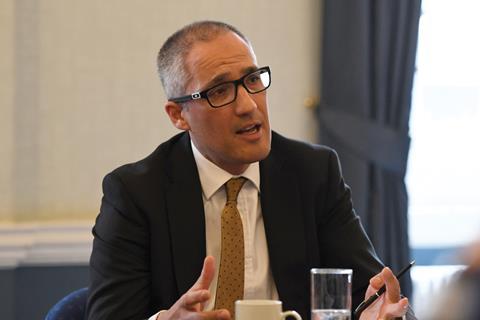In 1925 Russell Baker set up a law firm with an old school friend. They did not have much resource behind them – Baker had paid his way through university by working as a boxer at county fairs. Fast forward to 2017 and Baker McKenzie is a global behemoth, with offices in 77 countries.
Global dominance is not the stated aim of the small law firm founders around the Gazette’s latest roundtable, several of whom took the conscious decision to turn their backs on the culture and conditions of much larger firms in which they have (or could have) worked. But they are firmly focused on achieving business success on their own terms, and in doing so they bring a little of the ‘frontier spirit’ that Russell Baker’s successors say is in that firm’s DNA.
Contrary to popular belief, small firms are far from being a beleaguered subset of the profession. Last year, the SRA authorised a record number of new entities, predominantly in the one-to-four partner category (the Law Society’s definition of a ‘small firm’). As Tony Roe, founder of Reading-based divorce and family law practice Tony Roe Solicitors, reminds the group at the outset, small firms of solicitors ‘account for approximately 86% of our businesses – law firms by number – and 29,000 of our 160,000 solicitors’.
The diversity of practice within that group is striking, as evidenced by the specialisms of those at the roundtable.
There is Mark Seccombe, litigation manager at Brighton firm LA Law, which specialises in personal injury (an area dominated by the large PI firms of the north-west); and Sally Azarmi, founder of Azarmi Legal Services, which handles international trade, shipping and corporate immigration instructions from bases in the City, the south-east and the Middle East.
We’re working a lot with firms on retention and reward. Then, if a matter becomes litigated, obviously because we’re a law firm we do all that
— Jay Bhayani, Bhayani HR & Employment Law
Jay Bhayani set up her niche practice Bhayani HR & Employment Law in Sheffield two years ago; while Tony Roe struck out alone in divorce and family law a decade back.
Nicholas Woolf is principal of Chancery Lane litigation boutique Nicholas Woolf & Co; while Laura Devine, whose firm is the largest at five partners, opened her City immigration practice in 2003 and a New York office in 2007.
Paul Bennett’s Aaron & Partners specialises in advising professional partnerships from offices in Manchester, Chester and Shrewsbury; while Fergal Quinn’s Wysocki Quinn Woollam advises on the purchase and sale of superyachts and private jets.
Just one of those present, Philip Giles of Leigh-On-Sea, Essex firm Giles Wilson, identifies as an ‘old-fashioned-type, high street firm’. Founded 20 years ago, Wilson’s 15 fee-earners handle conveyancing, family law, probate and litigation for a local client base. Giles describes business as ‘buoyant’, his confidence underpinned by a strong local property market.
As businesses, small law firms get a mixed report card from partnership adviser Bennett, who counts them as clients. ‘I’m seeing from my client base two really interesting trends,’ he reflects. ‘There are firms doing really well, growing at a higher rate and standing out in the marketplace. They tend to be niche firms.’
In stark contrast, he adds: ‘I’ve got a client base in the north-west, which is predominantly a personal injury area, and those firms are very anxious’.
Some firms of course are beholden to civil justice reforms over which they have no control – some of which (such as whiplash) are effectively suspended pending the outcome of the general election.
‘Those firms are doing a mix of things,’ Bennett says. ‘Some have started to close down, some have started to sell off the bits of their practice that aren’t sustainable and some of them are just waiting to see what happens.
‘If you’re in personal injury and clinical negligence, you’re probably quite anxious. If you’re in other areas, because the consumer market’s buoyant and because business is buoyant, you tend to be doing quite well.’
Seccombe stresses: ‘Certainly, the hike in court fees has had a huge impact on small [firm] businesses in regards to cashflow and the office account. I don’t really see that the hike in court fees [has been] mirrored in the level of service received [from the courts].’
One imperative for small firms in this eclectic market is to identify ways they can use size to their advantage. Azarmi notes: ‘Someone like me can be very nimble, very quick. We can change, adapt and be flexible.’
Employment claims fell dramatically following the introduction of tribunal fees, which happened as Bhayani was trying to make a success of her new firm. Her response was to reshape her offering: ‘I set up my practice at precisely the time when there [was an] 80%-odd reduction in claims,’ she recalls. ‘People said “were you mad?”, but actually it was a really good opportunity to create something different.’
Bhayani HR & Employment Law now ‘offers everything from HR outsourcing through to the litigated employment work’. A good illustration is her work for law firm clients: ‘We’re working a lot with firms on retention and reward. Then, if a matter becomes litigated, obviously because we’re a law firm we do all that. That’s working quite well.’
‘Keep visible’ is Laura Devine’s advice. Although bracketed with much larger full-service firms by the legal directories, she believes large-firm clients are looking for a different service. Being niche is key to the success of her firm, which now has a headcount of 60. She says: ‘If you stay dedicated to one area, then I think you’re more likely to get referrals from other firms because they know you practise your area well. You’ll please the client… and you won’t take other work [from them].’ Her current plans for the firm do not involve getting any bigger, she adds: ‘I’d rather go on reputation and profit, rather than size.’
Giles believes the threat to the high street from large operations competing for instructions is overstated. ‘I think it’s a very difficult nut to crack,’ he observes. ‘Local people like to deal with local businesses.’ Exploiting that, though, requires more than simply being on the ‘high street’: ‘Everyone assumes that lawyers are good at what they do, and everyone assumes that lawyers are approachable and …friendly because we all say that we are.’ Advertising, marketing, branding and a good website are all key, he says: ‘You’ve got to be really visible, and… when they come to your website, they’ve got to like what they see. So if you can, create good credentials. Use awards [and] accreditations. It [might] make the difference.’
Giles may risk being undercut by larger ‘factories’, but others do not.
‘Most of our competitors are firms that probably do shipping and aviation, and certainly if they don’t specialise in it, they do it as large chunks of a wider commercial practice,’ Quinn explains. ‘I think for a while new clients have been getting quietly fed up, especially with the larger London firms increasing their rates year after year regardless of market conditions. We price ourselves very competitively, but our business model isn’t to grow our rates every year.’
His clients are able to pay higher rates – but wealthy people do not like being ‘ripped off’ any more than anyone else.
Technology and knowledge management are core to running small firms and have contributed to the proliferation of new businesses noted above. The web is key to unlocking client demand and has helped to reduce the marketing advantage enjoyed by larger firms.
When I started five years ago, I was being offered technology at huge cost. I did pay large sums and I didn’t need to
— Sally Azarmi, Azarmi Legal Services
Technology should support the running of a law firm by providing products that reduce overheads, Azarmi notes. Yet those present have an uneven experience of the largest legal technology providers. ‘When I first started five years ago, I was being offered these things at huge cost,’ Azarmi recalls. ‘I did pay large sums and I didn’t need [to].’
She now has a US time-recording app that costs $13 a month and case management software that costs £1,000 a year.
Others have experience of negotiating down lead providers, though this tends to involve multiple communications. ‘You need to keep battering away until you get to somebody who understands that you’re not [the larger firms] they’re used to dealing with,’ Woolf advises.
Roe relates a poor experience of a major cloud computing and IT support business. He now uses a small IT consultant whom he feels better understands his firm and its needs. Damningly, he adds: ‘The people who are selling the kit at a lot of these organisations really do not understand their product. And more importantly, they do not understand the small firm’s needs.’
Bhayani says the IT she needs is ‘very accessible and very cheap, and you can run a law firm on really quite a rudimentary system’. But she adds: ‘I think the big threat is cybersecurity.’
Woolf concurs, ruefully: ‘If a 15-year-old can get into the Pentagon, none of us have got any chance.’
Day to day, ‘cyber-enabled’ crime is a pressing risk now: ‘There’s always an element of manipulation,’ says Bennett, who advises firms on the regulatory implications of a successful breach that may put a firm in contravention of the SRA accounts rules. ‘Ultimately, it comes back to somebody, somewhere being manipulated to a point where they will either give information to somebody they think is a bank, or they will make a payment to a third party [when] they’re not sure who it is because they think somebody above them wants them to do that. With cybersecurity, everybody focuses on the technology – but actually you need to focus on the people as well.’
Policing
All present are regulated by the Solicitors Regulation Authority, and as law is a highly regulated sector the way these firms are policed has an impact on their business. There is praise for the day-to-day operation of the SRA under its current management.
Quinn says: ‘They were very professional when we set up. The process of making an application to be approved was relatively straightforward. It was bureaucratic, but you’d expect that. We had a dedicated caseworker at the SRA… and I thought they did a great job.’
The prospect of regulatory reform, driven by the Competition and Markets Authority’s focus on the legal sector, is of much greater concern. The CMA concluded that the wide range of fees charged for legal advice is a sign that competition in the legal market is not working and that price transparency is needed. A firm’s rates, the CMA suggested, should be published on its website for key areas of ‘consumer’-facing legal work.
On behalf of the Law Society’s Small Firms Division, Giles and Azarmi have held discussions with the SRA on proposals to meet the CMA’s concerns. ‘They didn’t seem to appreciate that a lot of clients…are extremely clued-up on price,’ Azarmi relates. That knowledge applies in the commercial sphere in which Azarmi works and for private client work. ‘They’ve been to a whole raft of other solicitors before they’ve come to me,’ she notes, ‘and it’s often not price that makes the decision, it’s the work that I offer. [But without] price transparency I wouldn’t get the work.’
Advertising price would most likely come in for areas such as wills and conveyancing. ‘We did talk about divorce in some detail,’ Giles says. ‘Divorce comes in two parts. Procedure is pretty easy to price, [whereas] sorting out finances or children is very difficult… We try to get the point across that a lot of what’s [being talked] about is simple stuff that’s also wealth-based. If you’re making a will or you’re buying a house, you’ve got money, so actually the service is not necessarily price-driven. And those are the two areas that are already highly competitive in the marketplace in terms of the amount that you can charge.’
It is not just the CMA that is creating uncertainty on regulation, Bennett notes. The SRA, he adds, has superintended regulatory change with a speed and frequency that is difficult for smaller firms to keep up with: ‘If you look at the 18 versions of the current SRA handbook, often when people have fallen foul of rules, what they’ve [actually] fallen foul of is evolving regulation.’
But if the speed of regulatory evolution is not to the liking of smaller firms, the high standard set for regulation can be very positive. Bhayani observes: ‘When I set up I did think about whether I actually need to be a regulated law firm because I could do away with a significant amount of cost and hassle if I were to set up as an employment law consultant.’ But she chose the ‘label of being SRA-regulated’, and uses it in her firm’s marketing materials: ‘It differentiates me from HR consultants who try to offer the same thing that I do because we do a lot of package work.’ Clients are protected by the regulation to which solicitors are subject; and as a law firm she can provide the reassurance of privilege.
‘Clients like it,’ she concludes.
Regulation supports the solicitor ‘brand’, currently being widely promoted by the Law Society – an initiative that Roe describes as ‘really, really important’. In his own practice area, he notes: ‘We see individuals going to family law consultants who promise the world. They’re not insured, they’re not regulated, they’re not qualified and we tidy up the mess of a lot of people who have tried to do something in a way that doesn’t involve a solicitor. You only get one go at this. You’re dealing with your kids, you’re dealing with your money, you’re dealing with your house, you’re dealing with your business. All of this is really important.’
Now hiring
The discussion concludes with what is often the very real problem of recruitment. Large, self-styled elite firms throw resources at the so-called ‘milk round’, targeting top universities and thereby operating in a different marketing league.
‘I find it very, very difficult,’ Giles says. ‘Recruitment is the number one headache for me, because it’s a two-pronged thing. It’s partly protecting the… good people you’ve got [who are] constantly being tapped up by recruitment agencies and other firms, and then trying to attract the right sort of talent.
‘We’re very close to London,’ he adds, ‘so we’re fishing in quite a difficult pond. The top talent will come to the City. I haven’t found a recruitment agent that I can work with yet that doesn’t send me CVs that they’re trying to get under my radar.’
You might look at a London City firm and think, “it’s going to be very lucrative”. Yes it certainly will be, but your life will be a misery
– Fergal Quinn, Wysocki Quinn Woollam
Being highly prescriptive about candidates’ professional profiles can be a mistake, it is noted. Bennett advises: ‘Recruit on personality, because ultimately everybody can get a law degree, the LPC, and to five years’ PQE fairly easily. You’ve got to recruit the right personality for [your] business.’
Smaller firms, Roe points out, have an advantage in their ‘pitch’ to candidates: ‘Because we are small, we can mentor much more. We can try to encourage people and bring them on. We can invest in them, both financially and time-wise.’
The faults of larger firms are also better known than in the past, Quinn observes: ‘In recent years the growth of websites such as RollOnFriday has been interesting, because this [shows] what life is like in a larger firm. You might look at a London City firm and think, “it’s going to be very lucrative”. Yes it certainly will be, but your life will be a misery. I think sites like RollOnFriday have helped demystify that whole City law culture.’
Roe notes the importance of getting the message understood that ‘small firms have big firm values’, equalling large competitors on advice and service.
For solicitors considering striking out alone, Bennett closes with some advice: ‘More years ago than I care to remember, I did a management qualification. I use it every single day.’ Good management, he says, is ‘fundamental to why the businesses around this table are thriving’.
The Law Society’s Small Firms Division offers a shared community to take advantage of expertise in marketing, business development, tax and accountancy, as well as news, campaigns and changes in regulation affecting small firms and sole practitioners. More details >>












































2 Readers' comments